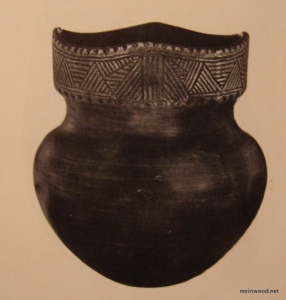
Inwood Hill Park has seen its share of activity through the centuries, but little has been written of the pottery studio that spawned generations of world class artists.
The Inwood Pottery Studio was founded in 1923 by Harry Voorhees and his wife, Aimee LePrince Voorhees.

While Harry was a former railroad and elevator engineer from  Rocky Hill, North Carolina, his wife, Aimee, came from an entirely different stock.
Rocky Hill, North Carolina, his wife, Aimee, came from an entirely different stock.
Born in Leeds, England Aimee arrived in New York with her parents in the 1890’s. Aimee’s father, a Frenchman named Augustin Le Prince, was a pioneer in the development of early motion picture cameras. Together her parents founded the Technical School of Art in Leeds, before moving the family to the Big Apple. Shortly after arriving on these shores, Aimee’s mother set up the New York Society of Ceramic Arts and held regular meetings in Manhattan’s Jumel Mansion.
 Needless to say, Aimee was the creative and driving force in the couple’s Inwood Hill studio.
Needless to say, Aimee was the creative and driving force in the couple’s Inwood Hill studio.
Their timing could not have been more opportune.
Subway construction and other earth moving projects in the 1920’s led to the unearthing and discovery of many priceless Native American artifacts; including shards and fully intact aboriginal pottery. The Voorhees were particularly interested in incorporating Indian pottery designs into their own work.
Past and present melded beautifully and the “Inwood School” of ceramic design was born.
In a pamphlet titled, “Inwood Hill Park on the Island of Manhattan,” published in 1932, local historian and archeologist Reginald Pelham Bolton writes:

“The work is carried on by these artists in a group of simple buildings, contiguous to a fisherman’s little cottage, which is an attractive feature of the shore line.
The attention of Aimee Voorhees has been particularly directed to the art of the American Indian, and her reproduction of the pottery of our local natives derived from fragments in the vicinity, and her development of Indian designs, are affording the means of appreciating the beauty of form, and the skillful simplicity of the aboriginal artists.
Classes are held in the Pottery, to which many students are attracted, who carry thence knowledge of our real American art. Groups of children gather to learn the pleasant work of plastic art. The products of the Pottery include some delightful and original forms.”
In fact, Bolton, in decades of digging though Inwood’s past, would discover many of the artifacts, including a fully intact Algonquin vase, that so inspired the Inwood Pottery School.

Another description of the Pottery Studio comes from “Round Manhattan’s Rim” published in 1934:
“They (The Voorhees) live in a small white frame house more than a century old. It was built for a retired sea captain seeking a snug harbor.
“We have never been able to find but his name, ‘Mr.Voorhees said, “but Pop Seeley told us stories about him. Pop lived here until he died. We got the house from him.’

It is a quaint, cheery little place with latticed windows and a snug quality. Oil lamps, coal stoves and open fires lend rural atmosphere. Back of it are the studios where the Inwood pottery is made. The clay used for the Indian bowls comes from the hills round-about.
Both Mr. and Mrs. Voorhees mold the pottery and give instruction in the making of it. The public-school teachers often come to the Inwood Studios for class work. It is a romantic spot and a unique one in which to study.”
Harry Voorhees died of pneumonia in March of 1934 at age 65. It would have broken his heart had he lived to see what was to become of his beloved Pottery.
In 1936 the City condemned the Inwood Pottery Studio and many other structures in Inwood Hill for the creation of the present Inwood Hill Park.
Despite loud local protest, the widow Voorhees and her studio were moved to 503 West 168th Street where new kilns were constructed and classes resumed once again.
But things would never be the same again.
In May of 1951, Aimee Voorhees passed away in New York Presbyterian Hospital at the age of 76.
Think you might have a piece of Inwood Pottery? Flip it over and look for the distinctive “Inwood Pottery NYC” stamp on bottom.
It’s hard to say what these beautiful pieces are worth today, but a 1929 letter to the Newark Museum describes ceramic plates, vases, jars and bowls ranging in price from $1.50 to fifty dollars.
For more on the Inwood Pottery Works, click here.

























This is wonderful ! I never realized there were so many different types of
Inwood Pottery! Well done Cole ! I think you`ll get quite a few raves !
Good Luck
Sincerely, Correna Anderson
[…] launching Myinwood.net I have posted quite a bit on the Inwood Pottery Studio; which once occupied Inwood Hill Park. The pottery, the houseboat community, the idyllic setting of […]
[…] boulders maybe 50,000 years old, a shell heap indicating hundreds of years of Indian feasting, the pottery studio of Harry and Aimee Voorhees and the Dyckman Institute with its […]
[…] electricity, considered their plot of shore, shaded by the famous Inwood Tulip, not far from the Inwood Pottery Works, to be the most tranquil and awe inspiring location in all of […]
What a wonderful website! The interview is so sweet. I have 5 pieces of Inwood and 4 of them are on the website! Great historical information. Thanks you so much, Steve Dana pottery collector.
[…] The Inwood Pottery Studio […]